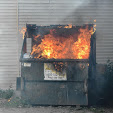Released at almost the same time as the Canon EOS 40D, the initial MSRP of the Nikon D300 was five hundred bucks higher, a more than 35% jump. The difference was that Nikon had already sliced the DSLR marked more finely than Canon had. Where Nikon had three tiers of cameras (“entry”, “upper entry”, and “enthusiast”) beneath its D300, the EOS 40D had to satisfy everyone too cool to buy a Rebel but not well-heeled enough for a full-frame 5D.
The D300 was launched at the same time as the D3 pro camera and, while it didn’t have the full-frame sensor or built-in vertical grip, it used Nikon’s pro control layout and rugged, weather-resistant construction. It also replaced the 10MP CCD sensor of its D200 predecessor with a new 12MP CMOS sensor, backed with Nikon’s new EXPEED image processor.
When I say that it uses Nikon's "pro control layout", the photo above is what I'm referring to. The pro cameras from Nikon (and Canon and Olympus) don't have a mode dial, like on consumer/hobbyist-oriented cameras, where the PASM modes often share space with Portrait, Landscape, Sports, et cetera. Instead you select among Program, Aperture Priority, Shutter Priority, and Manual by holding a mode button and spinning a dial. Similarly, controls like ISO and White Balance tend to be located where they're easy to access on the fly without having to dive into a menu on the screen.
The top panel's LCD screen has all the data you'd need about the camera's settings viewable at a glance when you power it up.
The power switch is the same one Nikon's been using across their DSLR and MILC lines pretty much universally for yoinks now, unlike Canon, who seem to want to experiment with a new location for the switch every so often. Right next to it, easily reached by the shooter's index finger, are the Mode and Exposure Compensation buttons.
The pentaprism viewfinder is bright, contains all the shooting info you need, and has true 100% coverage, as opposed to its predecessor's 95% coverage finder. Where the D200 had a 2.5" screen on the back, the D300 has a 3" LCD with more than 3X the pixel count. The controls are laid out in typical Nikon fashion. The little rotating latch with the Pac-Man pictogram at lower right is the remote release for the memory card door. The D300 records to a single CF card slot.
It has an in-body focus motor, allowing it to make use of older Nikon autofocus glass as well as newer lenses. The only new F-mount glass is can't handle are the lenses with electromagnetically-controlled apertures.
The D300 was expensive, but it was pretty much the state of the art in APS-C cameras circa 2008. Unless you need to shoot video or simply must have live view, there's no reason you couldn't
put it to work today.


















































